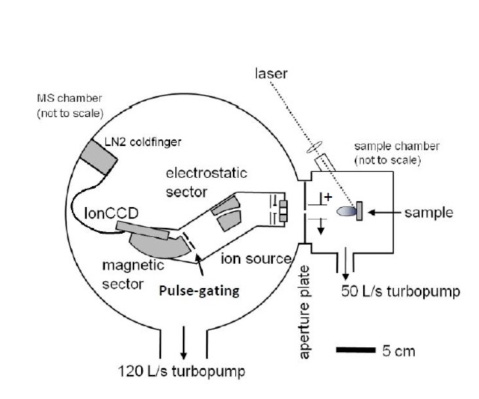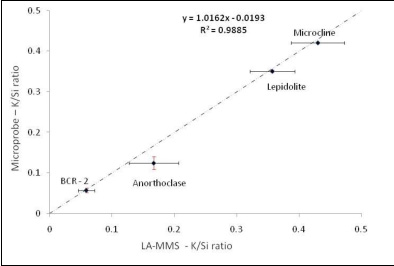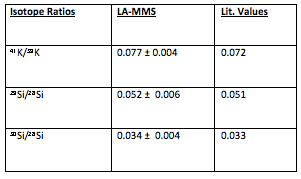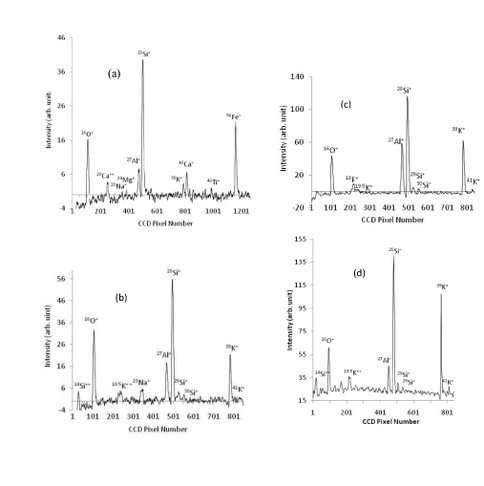2011 Annual Science Report
 University of Wisconsin
Reporting | SEP 2010 – AUG 2011
University of Wisconsin
Reporting | SEP 2010 – AUG 2011
Project 7B: Development of a Laser Ablation, Electron-Impact Miniature Mass Spectrometer (LA-EI-MMS) for in Situ Chemical and Isotopic Composition and Age Determinations of Martian Rocks
Project Summary
A prototype of laser ablation-miniature mass spectrometer (LA-MMS) instrument for geochemical and age dating of rocks on the surface of extraterrestrial bodies is being developed in this project. In the LA-MMS method the rock sample is ablated by a laser and the neutral species produced are analyzed using the JPL-invented MMS. The neutral atoms ablated by a pulsed laser from the rock are ionized by electron impaction; the resulting ions of different masses are then spatially dispersed along the focal plane of the magnetic sector of the miniature mass spectrometer (MMS) and measured in parallel by a modified CCD array detector capable of detecting ions directly. Chemical analysis and high precision isotope ratios of elements have been measured in various rock samples by LA-MMS. Work on the measurement of absolute age of these rock samples based on K-Ar radiogenic technique is in progress.
Project Progress
A laser ablation-miniature mass spectrometer (LA-MMS) instrument for performing chemical and isotopic analysis and age dating of rocks is being developed in this project. The rock sample is ablated by a laser and the neutral species produced are analyzed using the JPL-invented miniature mass spectrometer. In this method, the neutral atoms ablated by a pulsed laser are led into the electron impact ionization source of the MMS, where they are ionized by a 70 eV electron beam. This results in a secondary ion pulse typically 10-100 μs wide, compared to the original 5-10 nsec laser pulse duration. Ions of different masses are then spatially dispersed along the focal plane of the magnetic sector of the miniature mass spectrometer (MMS) and measured in parallel by a modified CCD array detector capable of detecting ions directly that offers a 100 % duty cycle over a wide mass range. An ion gating technique was implemented such that the CCD ion detector integrates ion signal for only the secondary ion pulse duration. Fig. 1 shows the schematic of the LA-MMS instrument.

Figure 1. Schematic of the LA-MMS instrument
This suppresses the contribution of ions generated from the background gases. LA-MMS offers a more quantitative assessment of elemental composition than techniques that detect ions directly generated by the ablation process. Currently, the LA-MMS limit of detection is 0.4 weight %. The LA-MMS has been used for elemental composition measurements of various minerals including microcline, lepidolite, anorthoclase and USGS BCR–2G samples. The measured mass spectra of these samples are shown in Fig. 2.
Figure 2. Mass spectra of laser ablated species from different minerals, (a) lepidolite, (b) anorthoclase, (c) USGS BCR-2G and (d) microcline measured by the miniature mass spectrometer with CCD direct ion-detector array.
The measured elemental values measured by LA-MMS agree closely with the ones determined by the Joel 8200 electron microprobe on the same samples. These values are compared in Fig.3.

Figure 3. The K/Si ratios of the minerals measured by LA-MMS are compared with the corresponding values by the analysis of these samples using a JEOL 8200 electron microprobe commercial electron microprobe instrument.
The measurements of high precision isotopic ratios including 41K/39K (0.077 ± 0.004) and 29Si/28Si (0.052 ± 0.006) in these minerals by LA-MMS were also made and are listed in table I.

TABLE I. Isotopic ratios of K and Si measured by LA-MMS on microcline, lepidolite and anorthoclase. A close agreement of these values with the natural abundance ratios is found.
The details of the work performed along with the developed new technologies in this reporting period (September 1, 2010 – August 31, 2011) are described in the papers published in Rev. Sci. Instrum. 82, 094102 (2011) and the various NASA Tech Briefs (see publication citations).
Work is in progress to enhance the sensitivity of the LA-MMS instrument and the measurement of ablated argon from the rock. Ar measurement will be made in the static mode of vacuum operation. This mode of operation will eliminate water using gettering material and other interfering species (e.g. Ca). The combined K and Ar measurements from a rock will enable the determination of the absolute age of the sample based on K-Ar radiogenic technique.
The LA-MMS has been developed as a prototype instrument system, hitherto unavailable, for space applications for geochemical and geochronological measurements on the surface of extraterrestrial bodies.
Publications
-
Sinha, M. P., Neidholdt, E. L., Hurowitz, J., Sturhahn, W., Beard, B., & Hecht, M. H. (2011). Laser ablation-miniature mass spectrometer for elemental and isotopic analysis of rocks. Review of Scientific Instruments, 82(9), 094102. doi:10.1063/1.3626794
- Hurowitz, J.e. & A. (2011). In-Situ K-Ar Geochronology: Age Dating for Solar System Sample Return Selection” and its Importance to Solar System Sample Return Missions for the Future of Planetary Sciences. 42nd Lunar and Planetary Science Conference.
- Hurowitz, J.e. & A. (2011). In-situ Potassium-Argon geochronology using fluxed fusion and a double spike. NASA Tech Brief, # 48099.
- Sinha, M.P., Hecht, M.H. & Hurowitz, J. (2011). In-Situ Geochemical Analysis and Age Dating of Rocks using Laser Ablation-Miniature Mass Spectrometer (LA-MMS). NASA Tech Brief, # 48250.
-
PROJECT INVESTIGATORS:
-
PROJECT MEMBERS:
Brian Beard
Co-Investigator
Michael Hecht
Research Staff
Joel Hurowitz
Research Staff
Evan Neidholdt
Research Staff
-
RELATED OBJECTIVES:
Objective 2.1
Mars exploration.
Objective 7.2
Biosignatures to be sought in nearby planetary systems
